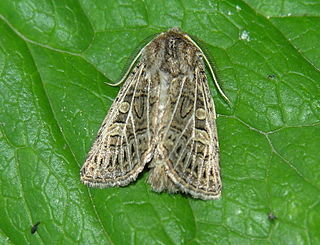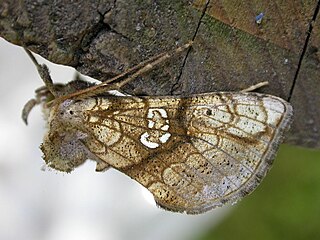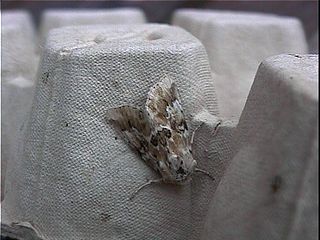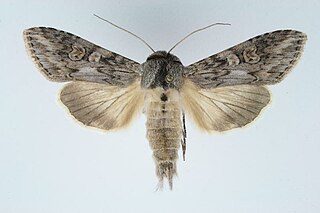
The flame shoulder is a moth of the family Noctuidae. The species was first described by Carl Linnaeus in 1761. It is distributed throughout the Palearctic from Ireland in the west to Siberia then Korea and Japan in the east.

The autumnal rustic is a moth of the family Noctuidae. The species was first described by Eugenius Johann Christoph Esper in 1788. It was previously placed in the genus Paradiarsia. It is found in northern and western Europe and North Africa.

Conistra rubiginosa, the black-spot chestnut, is a moth of the family Noctuidae. The species was first described by Giovanni Antonio Scopoli in his 1763 Entomologia Carniolica. It is found in Europe.

Heliothis peltigera, also known as the bordered straw, is a species of moth of the family Noctuidae.

Emmelia trabealis, the spotted sulphur, is a moth of the family Noctuidae. The species was first described by Giovanni Antonio Scopoli his 1763 Entomologia Carniolica.

Tholera decimalis, the feathered Gothic, is a species of moth of the family Noctuidae. It is found in Europe and Scandinavia then through the Palearctic to Asia minor, western Central Asia, southern Siberia and in North Africa.

Tiliacea citrago, the orange sallow, is a species of moth of the family Noctuidae. It is found in Europe as far east as the Caucasus Mountains and the Urals.

The Early Grey(Xylocampa areola) is a species of moth of the family Noctuidae. It is found in Europe and Morocco.

Xanthia gilvago, the dusky-lemon sallow, is a moth of the family Noctuidae. The species was first described by Michael Denis and Ignaz Schiffermüller in 1775. It is found in Europe.

Polychrysia moneta, the golden plusia, is a moth of the family Noctuidae. It is found in the Palearctic realm.

Mythimna conigera, the brown-line bright-eye, is a moth of the family Noctuidae.

Eremobia ochroleuca, the dusky sallow, is a moth of the family Noctuidae. It is found in Central and Southern Europe and the Middle East.

Cucullia argentea, the green silver-spangled shark, is a moth of the family Noctuidae. The species was first described by Johann Siegfried Hufnagel in 1766. It is found in southern and central Europe through Siberia, Mongolia and Manchuria up to Korea and Japan.

Coranarta cordigera, the small dark yellow underwing, is a moth of the family Noctuidae. The species was first described by Carl Peter Thunberg in 1788. It can be found in parts of Europe, mainly in the north. In central and southern Europe it is only found in mountainous areas. In the Alps for instance, it is found up to elevations of 2,200 meters.

The green-brindled dot is a species of moth of the family Noctuidae. It is found in southern Europe and the Middle East, then east to Iran and Ukraine. In Germany it is found up to the Eifel and Ahr.

Cosmia affinis, the lesser-spotted pinion, is a moth of the family Noctuidae. It is found in central and southern Europe, north to Great Britain, Denmark, southern Sweden up to Saint Petersburg. East, its range extends through northern and Central Asia up to Japan. It is also found in north-western Africa.

Agrochola litura, the brown-spot pinion, is a moth of the family Noctuidae. The species was first described by Carl Linnaeus in 1761. It is found in Europe and the Middle East. It is possibly also present in North Africa, but this is unclear because similar looking species Agrochola meridionalis is found there.

Cucullia santolinae is a moth of the family Noctuidae. It is found in southern Europe, northern Africa, Turkey, the Caucasus region and Israel.

The shoulder-striped clover is a species of moth of the family Noctuidae. It is found in most of Europe, Ukraine, southern Russia and southern Siberia, Transbaikalia, Turkey, central Asia, China, Japan, the Korean Peninsula, Mongolia, northern India, Pakistan, the Russian Far East.

Cucullia artemisiae, or scarce wormwood, is a moth of the family Noctuidae. The species was first described by Johann Siegfried Hufnagel in 1766. It is found from central and southern Europe to Turkey and across the Palearctic to western Siberia, Central Asia, Manchuria, the Korean Peninsula and Japan.





















